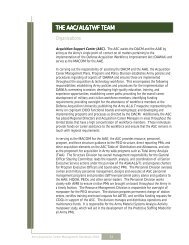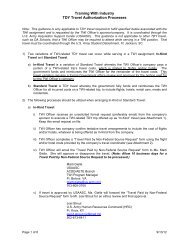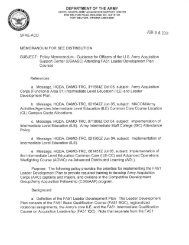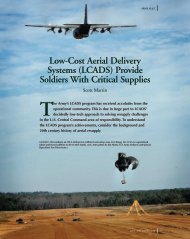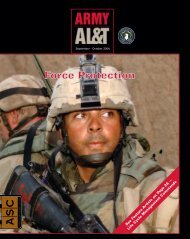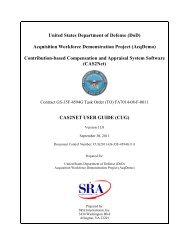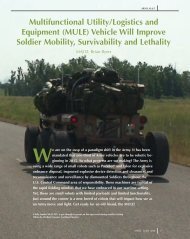Career Management Handbook - U.S. Army
Career Management Handbook - U.S. Army
Career Management Handbook - U.S. Army
Create successful ePaper yourself
Turn your PDF publications into a flip-book with our unique Google optimized e-Paper software.
AA AAC AA C ST STATUT ST TUT TUTOR TUT OR ORY/REGULA<br />
OR Y/REGULA Y/REGULATOR<br />
Y/REGULA OR ORY OR<br />
REQUIREMENT<br />
REQUIREMENTS/ARMY REQUIREMENT S/ARMY POLICIES<br />
POLICIES<br />
Acquisition <strong>Career</strong> Field (ACF) Position Certification<br />
Requirements<br />
DAWIA requires that the Secretary of Defense establish education, training, and<br />
experience requirements for all acquisition positions based on the level of complexity of<br />
the duties carried out in the position. The ACF Functional Boards have established<br />
position requirements for each acquisition career field and have divided the requirements<br />
into three levels. Each organization determines the certification level and the<br />
Acquisition Position Code category required by a position. The career levels are<br />
described below. (NOTE: The grades associated with each level should be used as a<br />
guide.)<br />
Level I (Basic Level). This level is for individuals generally in grades GS-5 through GS-8/<br />
personnel demonstration project broadband and Captain. Basic level training standards<br />
are designed to establish fundamental qualifications and expertise in the individual’s job<br />
series, functional area, or career field. Development at the basic level lays the foundation<br />
for career progression and is designed to prepare qualified, motivated personnel for<br />
positions of increasing responsibility.<br />
Level II (Intermediate Level). This level is for individuals generally in the grades of GS-9<br />
through GS-12/personnel demonstration project broadband and majors. At the<br />
beginning of the intermediate level, specialization is emphasized. Individuals should<br />
later begin to broaden their backgrounds toward a more general expertise in the overall<br />
processes of their career field. A lateral movement (reassignment) to a related specialty<br />
should optimally follow development of the expertise in the individual’s primary career<br />
field.<br />
Level III (Senior Level). This level is for individuals generally in the grades of GS-13/<br />
personnel demonstration project equivalent and Lieutenant Colonel and above. By the<br />
time individuals reach Level III, they should have completed all the mandatory training<br />
and education requirements (or equivalents) up to that level and should have advanced<br />
through a career path that has given them in-depth knowledge in their career field and a<br />
breadth of knowledge across the entire acquisition process.<br />
ACF Position Certification requirements are detailed in DOD 5000.52-M. The most<br />
updated requirements are documented in the DAU Catalog, which may be accessed at<br />
http://www.dau.mil/ (For more information on DAU, see the “<strong>Career</strong><br />
Opportunities” section of this handbook.) Certification in the position occupied is a<br />
condition of employment. Once in an acquisition position, you have up to 18 months<br />
to meet the level of certification required of the position. It is your responsibility to<br />
work with your supervisor to include the mandatory certification training and/or<br />
education requirements on your IDP. Note: Level II certification or training is required<br />
for AAC membership. Therefore, individuals selected for a CAP must have Level II<br />
certification or training at the time of selection; they then have 18 months to become<br />
Level III certified, as required for all CAPs.<br />
<strong>Army</strong> Acquisition <strong>Career</strong> <strong>Management</strong> <strong>Handbook</strong> 2003<br />
90



